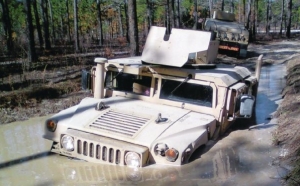
Over the last few entries we’ve kind of moved back and forth over man-improved and man made obstacles. We’ve covered hills, slopes, roads and trails, and bridges. Now we’re going to examine a few ways to use water as a natural, man-improved, and man made obstacle.
Bodies of water exist in a few different forms in rural communities. Rivers, creeks, streams, and ponds all present a movement challenge to the threat. Not only is it difficult to move through a shallow body of water for dismounts but water in any significant depth will prevent most wheeled vehicles from crossing. It’s not just the depth or speed of the water itself but when coupled with a bottom that is thick mud or a material like loose shale wheeled vehicles loose traction pretty quickly. If the water is deep enough and an engine running at operating temperature hits it there’s a couple of things that happen. Of course steam is produced however water is a lot like air in one aspect – it will seek any opening and fill that opening. So any kind of breather or dipstick without a good check valve is going to get backfilled. And water in a crankcase is death for a running engine. There’s four basic ways water can be enhanced as an obstacle: Speed, depth, width, and clutter. It’s pretty difficult to speed water up so we’re going to skip that one. Depth is a little bit easier. The average pickup truck has an air intake that is approximately 3 feet above ground level – not too hard to achieve. In reality you should go for as much depth as possible – HMMWV air intakes are often rerouted above the cab so six feet is better. Six feet also gives you something else – a higher water level than the air intake on an M113 APC. Rule of thumb – as deep as possible – the deeper the better. If the increased total depth after modification is less than 2 to 3 feet then it may be a waste of effort. More on that in a bit.
More @ The Lizard Farmer

No comments:
Post a Comment